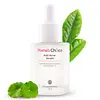What's inside
What's inside
 Key Ingredients
Key Ingredients

 Benefits
Benefits

 Concerns
Concerns

 Ingredients Side-by-side
Ingredients Side-by-side

Water
Skin ConditioningButylene Glycol
HumectantNiacinamide
SmoothingAmmonium Acryloyldimethyltaurate/Carboxyethyl Acrylate Crosspolymer
Glycerin
HumectantSodium PCA
HumectantEthylhexylglycerin
Skin ConditioningAllantoin
Skin ConditioningChlorphenesin
AntimicrobialPropanediol
SolventDisodium EDTA
Dipotassium Glycyrrhizate
HumectantMenthyl Lactate
MaskingPanthenol
Skin ConditioningCamellia Sinensis Leaf Extract
AntimicrobialCentella Asiatica Extract
Cleansing1,2-Hexanediol
Skin ConditioningLavandula Angustifolia Oil
MaskingPeucedanum Graveolens Extract
TonicSodium Hyaluronate
HumectantCeramide NP
Skin ConditioningEruca Sativa Leaf Extract
Skin ConditioningHydroxypropyltrimonium Hyaluronate
Hydrolyzed Hyaluronic Acid
HumectantHyaluronic Acid
HumectantHydrolyzed Sodium Hyaluronate
Skin ConditioningPentylene Glycol
Skin ConditioningPotassium Hyaluronate
Skin ConditioningSodium Hyaluronate Crosspolymer
HumectantSodium Acetylated Hyaluronate
HumectantWater, Butylene Glycol, Niacinamide, Ammonium Acryloyldimethyltaurate/Carboxyethyl Acrylate Crosspolymer, Glycerin, Sodium PCA, Ethylhexylglycerin, Allantoin, Chlorphenesin, Propanediol, Disodium EDTA, Dipotassium Glycyrrhizate, Menthyl Lactate, Panthenol, Camellia Sinensis Leaf Extract, Centella Asiatica Extract, 1,2-Hexanediol, Lavandula Angustifolia Oil, Peucedanum Graveolens Extract, Sodium Hyaluronate, Ceramide NP, Eruca Sativa Leaf Extract, Hydroxypropyltrimonium Hyaluronate, Hydrolyzed Hyaluronic Acid, Hyaluronic Acid, Hydrolyzed Sodium Hyaluronate, Pentylene Glycol, Potassium Hyaluronate, Sodium Hyaluronate Crosspolymer, Sodium Acetylated Hyaluronate
Ingredients Explained
These ingredients are found in both products.
Ingredients higher up in an ingredient list are typically present in a larger amount.
Allantoin is a soothing ingredient known for its protective and moisturizingg properties. Because of this, it is often added to products with strong active ingredients.
Studies show higher concentrations of this ingredient can promote wound healing.
Though it can be derived from the comfrey plant, allantoin is produced synthetically for cosmetic products to ensure purity.
Learn more about AllantoinCentella Asiatica Extract (Centella) is derived from an herb native to Southeast Asia. It is famous for its anti-inflammatory and soothing properties.
Centella is rich in antioxidants and amino acids, such as Madecassic Acid and Asiaticoside.
Studies show the compounds in centella help with:
The combination of all these properties makes centella effective at soothing, hydrating, and protecting the skin.
Other great components of centella include Vitamin A, vitamin C, several B vitamins, and Asiatic Acid.
Fun fact: Centella has been used as a medicine and in food for many centuries. As a medicine, it is used to treat burns, scratches, and wounds.
Learn more about Centella Asiatica ExtractDisodium EDTA plays a role in making products more stable by aiding other preservatives.
It is a chelating agent, meaning it neutralizes metal ions that may be found in a product.
Disodium EDTA is a salt of edetic acid and is found to be safe in cosmetic ingredients.
Learn more about Disodium EDTAWater. It's the most common cosmetic ingredient of all. You'll usually see it at the top of ingredient lists, meaning that it makes up the largest part of the product.
So why is it so popular? Water most often acts as a solvent - this means that it helps dissolve other ingredients into the formulation.
You'll also recognize water as that liquid we all need to stay alive. If you see this, drink a glass of water. Stay hydrated!
Learn more about Water